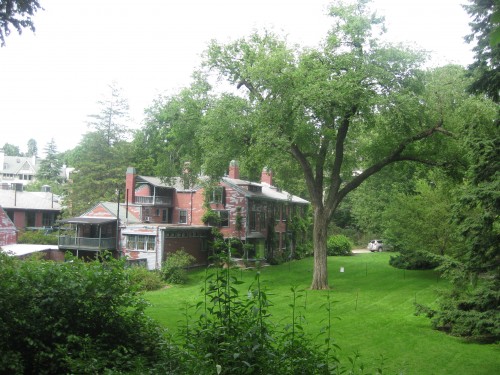Home … and Not-So-Sweet Home
While in Boston, had the opportunity to visit Fairsted (Olmsted’s home during some of the most productive years of his life) and McLean asylum (Olmsted’s home at the end of his life).
Fairsted, located in Brookline, Mass., is a national historic site maintained by the U.S. park service. It’s currently closed to the public and undergoing extensive renovation, as you can see in the photo below. Thanks to Alan Banks, a park ranger, for making special provisions and showing me around. Not only did Olmsted live at Fairsted for 12 years, but two of his sons carried on the landscape architecture practice here until the 1950s. This house is a mecca for landscape architects; thousands of original Olmsted firm park plans are stored here in a fire-proof, temperature-controlled vault.
The grounds surrounding the house are also notable. This was literally Olmsted’s yard. His planting scheme has been rigorously upheld; stone archways and other design touches remain intact — and even some original trees remain.
The Olmsted elm (also pictured below) was already on the property when FLO moved here in 1883. He especially loved this tree; elms always reminded him of his Connecticut boyhood. For all these many years, the tree has managed to stave off the ravages of Dutch elm disease. But now the Olmsted elm — estimated at 170 years old — is nearing the end of its natural life.

Arborists have saved samples of the Olmsted elm’s genetic material. When it dies, hopefully it will be possible to grow a clone Olmsted elm in its place. Once Fairsted is refurbished, the plan is to let the vines go wild, blanketing the house as they did in Olmsted’s day (see thumbnail of this post.) Olmsted liked having the structure of his home subsumed by nature — only fitting, since he was a landscape architect.
McLean hospital, in Waverly, Mass., proved a more somber spot to visit. Early in his career, Olmsted designed the grounds surrounding this asylum. It is where Olmsted spent the last seven years of his life. According to a previous biography, Olmsted lived in a residence here called Hope Cottage. The name has a nice, ironic ring to it. “But it’s also impossible,” archivist Terry Bragg told me. “Hope Cottage wasn’t even built in Olmsted’s day.”
More likely, according to Bragg, Olmsted lived in Proctor Hall. One thing that’s certain: On becoming a resident of McLean, Olmsted was not pleased with the way his landscaping design had been carried out. “Confound them! They didn’t follow my plan,” he said. He’d be even less pleased today. McLean — struggling with finances like so many medical facilities — has been forced to sell off whole big swaths of its grounds. One of the original residence halls was recently sold, too. A developer plans to turn it into condos.